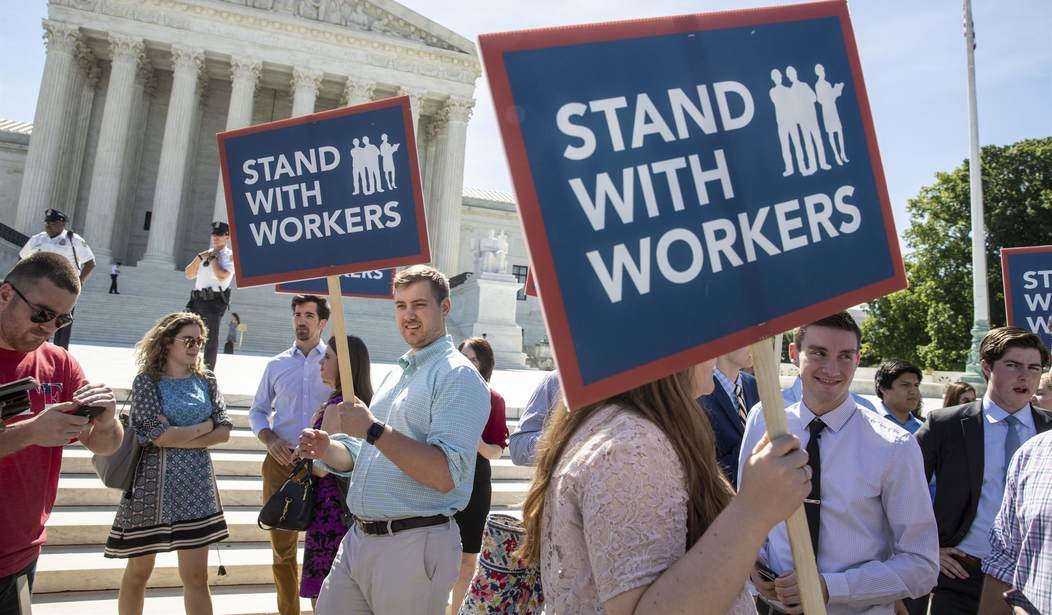(The opinions expressed in guest op-eds are those of the writer and do not necessarily represent the views of RedState.com.)
The U.S. Supreme Court’s ruling in Janus v. American Federation of State, County and Municipal Employees (AFSCME) — issued four years ago last week — inflicted a mortal wound on America’s public-sector unions.
But wounded isn’t dead.
On paper, the June 27, 2018, decision recognized that the 23 states in which government employees were compelled to either join a union as a dues-paying member or subsidize its activities through agency fees were violating the workers’ First Amendment rights to free speech and association.
This should have opened the floodgates for hundreds of thousands of workers to end their union affiliation overnight. But like a tanker ship in mid-ocean, the public-sector union leviathan couldn’t be turned on a dime.
Rather than simply complying with the unambiguous wording and intent laid out in Janus, unions like AFSCME, the Service Employees International Union (SEIU), the Brotherhood of Teamsters, the National Education Association (NEA), and the American Federation of Teachers (AFT) responded to the ruling by doubling down on their bullying tactics.
Even before the ink was dry, union leaders were in full-on denial, arguing it only applied to workers who had already opted out. Not surprisingly, they refused to inform members of their newly affirmed opt-out rights and, when confronted, often told workers nothing had changed.
No other private organization in the country would have had the chutzpah to try something so audacious but operating under a government-enforced monopoly for 50 years creates a definite sense of entitlement.
The unions embraced a policy of challenging every single opt-out request by ignoring them outright, using their vast resources to battle under-funded defectors in court, and, when all else failed, brazenly forging the employee’s signature on a membership agreement.
Faced with the daunting prospect of taking on the union machine, only a relative handful of workers even tried to opt out in most parts of the country.
The notable exception, however, was on the west coast, where a nonprofit organization known as the Freedom Foundation made a commitment to help government employees overcome the union obstacles.
It did this by:
- mobilizing an army of paid canvassers, who have visited tens of thousands of public employees in their homes and workplaces to inform them of their constitutional rights;
- creating a full range of marketing materials — including direct mail and email pieces, news releases and op-ed submissions, radio and television appearances, videos, and social media content — designed to tell government workers what their union won’t;
- establishing a nationwide outreach network to provide employees with the materials, information, and support they need to obtain their freedom; and,
- offering free legal representation to workers when needed.
Opt-out rates were found to be much higher in states where there was an active effort to cut through the union noise, suggesting that many — perhaps most — government employees bear their union no great love.
Unfortunately, a law is only as good as the enthusiasm with which it is enforced, and the track record where Janus is concerned still leaves much to be desired.
The four years since the ruling was issued have largely been distinguished by a series of lower court decisions that use pretzel-twisted logic to excuse unions’ blatant defiance of the clearly worded ruling and — so far, at least — the frustrating reluctance of SCOTUS to defend its own handiwork in several important follow-up lawsuits.
But with a number of intriguing cases still in the pipeline, it’s only a matter of time before Janus gets the necessary reinforcement.
Ultimately, keeping score is complicated by many factors, including varying reporting standards in different states and the unions’ penchant for fudging numbers. By itself, however, the Freedom Foundation has helped more than 117,000 government employees out of union bondage.
At an average of $900 per member in lost dues, that translates to more than $105 million every year the unions can no longer spend to advance their radically liberal political agenda.
In Washington state, where the Freedom Foundation was founded in 1991, state employee membership rates in AFSCME Council 28 and SEIU Healthcare 1199 have been slashed by more than a third. In neighboring Oregon, the rate of state workers paying dues or fees to SEIU 503 — the state’s largest union — declined by 37 percent, while AFSCME Council 75’s membership rate declined from 100 to 74 percent since 2018.
In sum, the opt-out results since Janus have been both encouraging and disappointing. While it’s gratifying that so many have won their freedom in the face of the unions’ unrelenting opposition, there remains much work to do.
Unionized government workers are eager to opt out once they learn they can — and that someone has their back.
But it doesn’t happen by itself. You have to work at it.
Aaron Withe is the CEO of the Freedom Foundation. www.FreedomFoundation.com













Join the conversation as a VIP Member